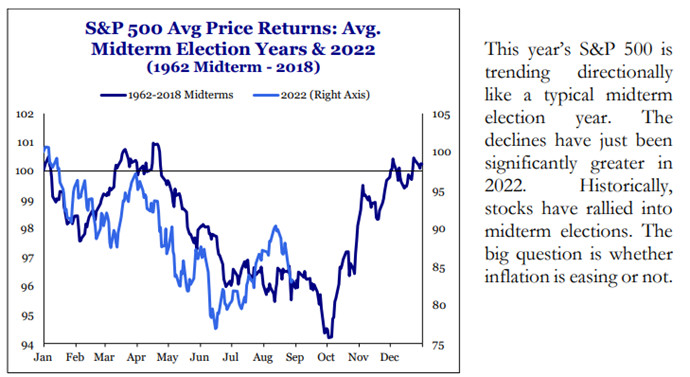On April 27 we shared a Special Market Alert entitled “Escalators, Not Elevators”. Why does investing in the stock market, also add the bond market this year, feel like taking an escalator up, and riding an elevator down? Rising markets seem to be slow upward climbs, like an escalator; the rise occurs over extended time (months and years). But a correction or bear market, defined as a decline of -20% or more, occurs quickly (days and weeks, or months), like riding an elevator down. It seems to take a year to earn 10% in a rising market, but a few days to lose 10%. The elevator experience is always uncomfortable and creates anxiety. Yes, anxiety for us too as we manage client accounts with great care and effort.
The Federal Reserve raised interest rates another 0.75% yesterday, September 21. It is their third such “mega”-increase in a row; and the 5th rate increase since March. The Fed also communicated expectation for another 125 basis points of rate hikes to still occur before year-end (next meeting is November 1-2), and potentially one more hike in early 2023 which could raise short Fed Funds rates to 4.25% to 4.5%. The Fed shared it believes it premature and a mistake to pause from the current path as they remain vigilant attacking sticky inflation. Comments from the Fed indicate they expect to cause economic pain, raising the risk of a recession as they attempt destroy job openings without triggering widespread layoffs, and aggressively attack inflation. [Sticky inflation – in rent/housing, food, energy – causes wage increases that perpetuate the condition.] Thus, the strong language (tone) from the Fed since mid-August is creating new stress in the markets. Since August 16, the end of a nice two-month rally, the S&P500 dropped -11.8%; the index is again off more than 20% since its last closing high on January 3, 2022. It was down as much as -23% early this summer on June 16. Thus, current market action is testing the lows touched earlier this year. This is a normal, but not fun process. During a bear market, the drawdown and/or bottoming process involves re-test of a previous low, further eroding investor sentiment. Often, the low is not breached; but when a breach does occur, further testing of a new low is often required, which unfortunately implies more time.
Let’s share several thoughts to consider:
- Bear market action feels like madness to investors. During any bear market, it is most uncomfortable and unsettling, because no one knows how bad or how long the drawdown will be. Living in the unknown makes the current experience the “worst.”
- Financial markets, stocks in particular, are forward looking. Stocks look 6 to 9 months into the future. While most investors’ outlook is dim, we may not yet be at the point where most things look miserable. That is a point where exasperation hits. Exasperation says “I can’t take it any longer;” “Get me out!” That point will prove, with hindsight, to be where the market bottoms. When things look most miserable, market bottoms are created. Are we near the low/bottom? That is a difficult question to answer, as no one can offer that prediction (no crystal ball). Bear markets are a process of correcting (and often overshooting) excesses, and that takes time.
- Most client portfolios do not own only stocks. They also own bonds which usually provide downside protection. Even in this year of bad bond market returns, they are down less than stocks; they are not providing the usual diversification hedge or benefit. For clients investing with a conservative objective (more bonds than stocks), pursuing an “income-oriented” path is now finding attractive yields in historically less risky assets, like bonds. Following the recent rate increases (from zero), 1-year US Treasury yields are 4%. That’s a higher yield than stock sectors: Energy (3.7%), or Real Estate (3.2%), or Utilities (2.9%, or the S&P500 (1.7%).
- Owning both stocks and bonds is prudent. Bonds struggle to combat (beat) inflation. Stocks are an investor’s only real weapon to beat the twin enemies of inflation and taxes over time. While stock returns are more painful during bear markets, they provide higher returns than many asset alternatives and keep or exceed the pace of inflation given time.
- Time is an investors’ greatest ally. It is imperative that appropriate investment objectives continue in place even during bear market “rainy” days. Avoid getting emotional during such times, as selling instead of remaining invested will result in long term damage that is most difficult from which to recover. An upcoming rally will turn into the next bull market advance; missing its beginning is missing a lot.
We too dislike market turmoil and uncertainty. We agonize over it on your behalf. This is because it is always difficult to see through market “storm clouds” – what will end the current drawdown or provide respite? Are we near peak “tough-talk” from the Fed if y/y inflation comparisons continue to slow (certainly possible)? Will the strong historical precedent of a post-midterm election bounce (no negative market experience in the 12 months following a midterm election since 1950) hold again this year? We believe it would be a mistake to dismiss these as possibilities, and thereby provide an “escalator” rise. You are encouraged to visit with us as we would like to hear/listen to your thoughts, ideas, and concerns.
